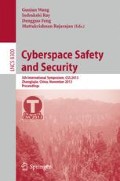Abstract
In this work, a new method for classification is proposed consisting of a combination of feature selection, normalization, fuzzy C means clustering algorithm and C4.5 decision tree algorithm. The aim of this method is to improve the performance of the classifier by using selected features. The fuzzy C means clustering method is used to partition the training instances into clusters. On each cluster, we build a decision tree using C4.5 algorithm. Experiments on the KDD CUP 99 data set shows that our proposed method in detecting intrusion achieves better performance while reducing the relevant features by more than 80%.
Access this chapter
Tax calculation will be finalised at checkout
Purchases are for personal use only
Preview
Unable to display preview. Download preview PDF.
References
Tajbakhsh, A., Rahmati, M., Mirzaei, A.: Intrusion detection using fuzzy association rules. Applied Soft Computing 9(2), 462–469 (2009)
Casas, P., Mazel, J., Owezarski, P.: Unsupervised network intrusion detection systems: Detecting the unknown without knowledge. Computer Communications 35(7), 772–783 (2012)
Bolón-Canedo, V., Sánchez-Maroño, N., Alonso-Betanzos, A.: Feature selection and classification in multiple class datasets: An application to kdd cup 99 dataset. Expert Systems with Applications 38(5), 5947–5957 (2011)
Chebrolu, S., Abraham, A., Thomas, J.P.: Feature deduction and ensemble design of intrusion detection systems. Computers & Security 24(4), 295–307 (2005)
Mukkamala, S., Sung, A.H.: Feature ranking and selection for intrusion detection systems using support vector machines. In: Proceedings of the Second Digital Forensic Research Workshop. Citeseer (2002)
Lin, S.-W., Ying, K.-C., Lee, C.-Y., Lee, Z.-J.: An intelligent algorithm with feature selection and decision rules applied to anomaly intrusion detection. Applied Soft Computing 12(10), 3285–3290 (2012)
Amiri, F., Rezaei, Y., Mohammad, M., Lucas, C., Shakery, A., Yazdani, N.: Mutual information-based feature selection for intrusion detection systems. Journal of Network and Computer Applications 34(4), 1184–1199 (2011)
Muniyandi, A.P., Rajeswari, R., Rajaram, R.: Network anomaly detection by cascading k-means clustering and c4. 5 decision tree algorithm. Procedia Engineering 30, 174–182 (2012)
Altwaijry, H.: Bayesian based intrusion detection system. In: IAENG Transactions on Engineering Technologies, pp. 29–44. Springer (2013)
Parsons, L., Haque, E., Liu, H.: Subspace clustering for high dimensional data: a review. ACM SIGKDD Explorations Newsletter 6(1), 90–105 (2004)
Fred, A.L., Jain, A.K.: Combining multiple clusterings using evidence accumulation. IEEE Transactions on Pattern Analysis and Machine Intelligence 27(6), 835–850 (2005)
Ester, M., Kriegel, H.-P., Sander, J., Xu, X.: A density-based algorithm for discovering clusters in large spatial databases with noise. In: KDD, vol. 96, pp. 226–231 (1996)
Leung, K., Leckie, C.: Unsupervised anomaly detection in network intrusion detection using clusters. In: Proceedings of the Twenty-Eighth Australasian Conference on Computer Science, vol. 38, pp. 333–342. Australian Computer Society, Inc. (2005)
Portnoy, L., Eskin, E., Stolfo, S.: Intrusion detection with unlabeled data using clustering. In: Proceedings of ACM CSS Workshop on Data Mining Applied to Security (DMSA 2001). Citeseer (2001)
Kayacik, H.G., Zincir-Heywood, A.N., Heywood, M.I.: Selecting features for intrusion detection: a feature relevance analysis on kdd 99 intrusion detection datasets. In: Proceedings of the Third Annual Conference on Privacy, Security and Trust. Citeseer (2005)
Cho, J., Lee, C., Cho, S., Song, J.H., Lim, J., Moon, J.: A statistical model for network data analysis: Kdd cup 99data evaluation and its comparing with mit lincoln laboratory network data. Simulation Modelling Practice and Theory 18(4), 431–435 (2010)
Tavallaee, M., Bagheri, E., Lu, W., Ghorbani, A.-A.: A detailed analysis of the kdd cup 99 data set. In: Proceedings of the Second IEEE Symposium on Computational Intelligence for Security and Defence Applications (2009)
Author information
Authors and Affiliations
Editor information
Editors and Affiliations
Rights and permissions
Copyright information
© 2013 Springer International Publishing Switzerland
About this paper
Cite this paper
Song, J., Zhu, Z., Scully, P., Price, C. (2013). Selecting Features for Anomaly Intrusion Detection: A Novel Method using Fuzzy C Means and Decision Tree Classification. In: Wang, G., Ray, I., Feng, D., Rajarajan, M. (eds) Cyberspace Safety and Security. CSS 2013. Lecture Notes in Computer Science, vol 8300. Springer, Cham. https://doi.org/10.1007/978-3-319-03584-0_22
Download citation
DOI: https://doi.org/10.1007/978-3-319-03584-0_22
Publisher Name: Springer, Cham
Print ISBN: 978-3-319-03583-3
Online ISBN: 978-3-319-03584-0
eBook Packages: Computer ScienceComputer Science (R0)

